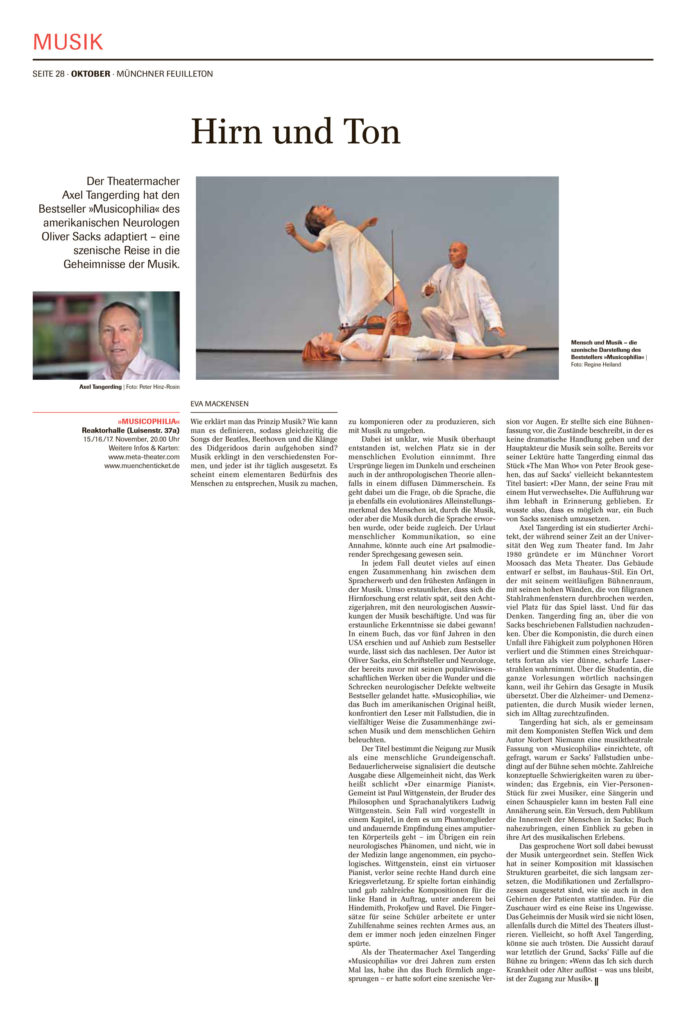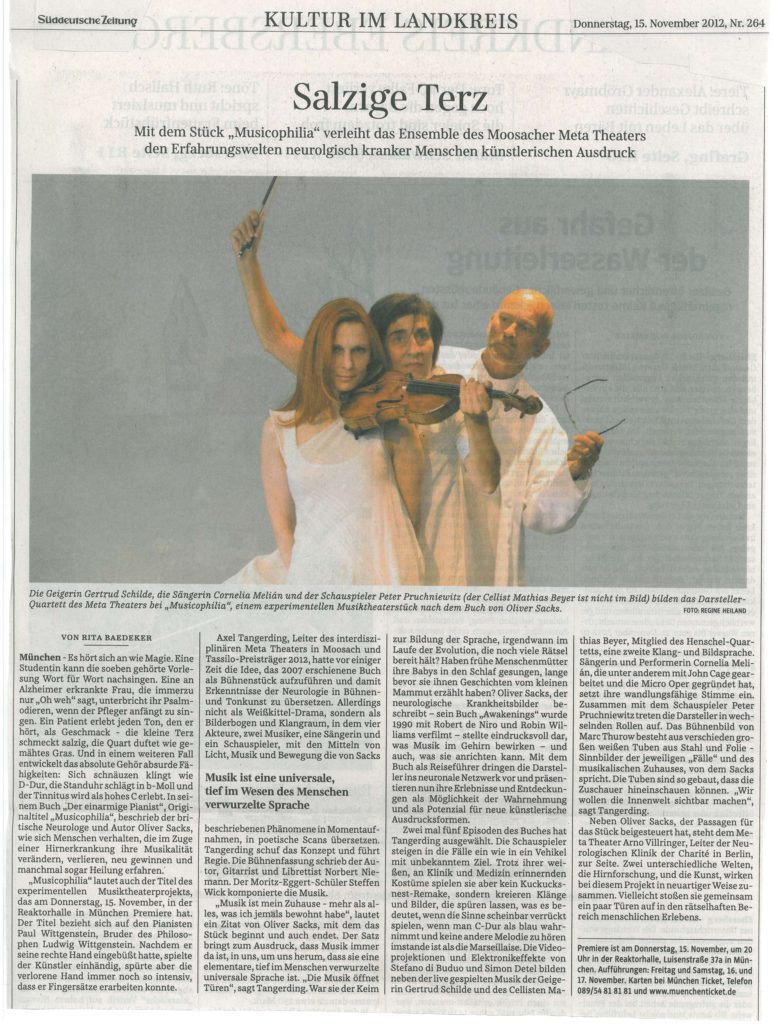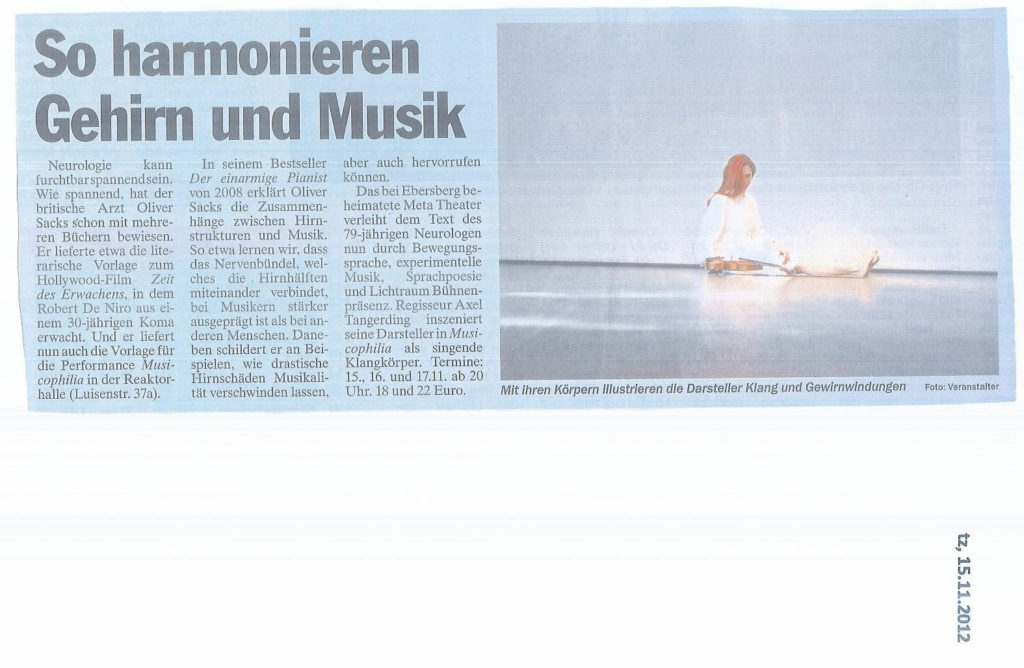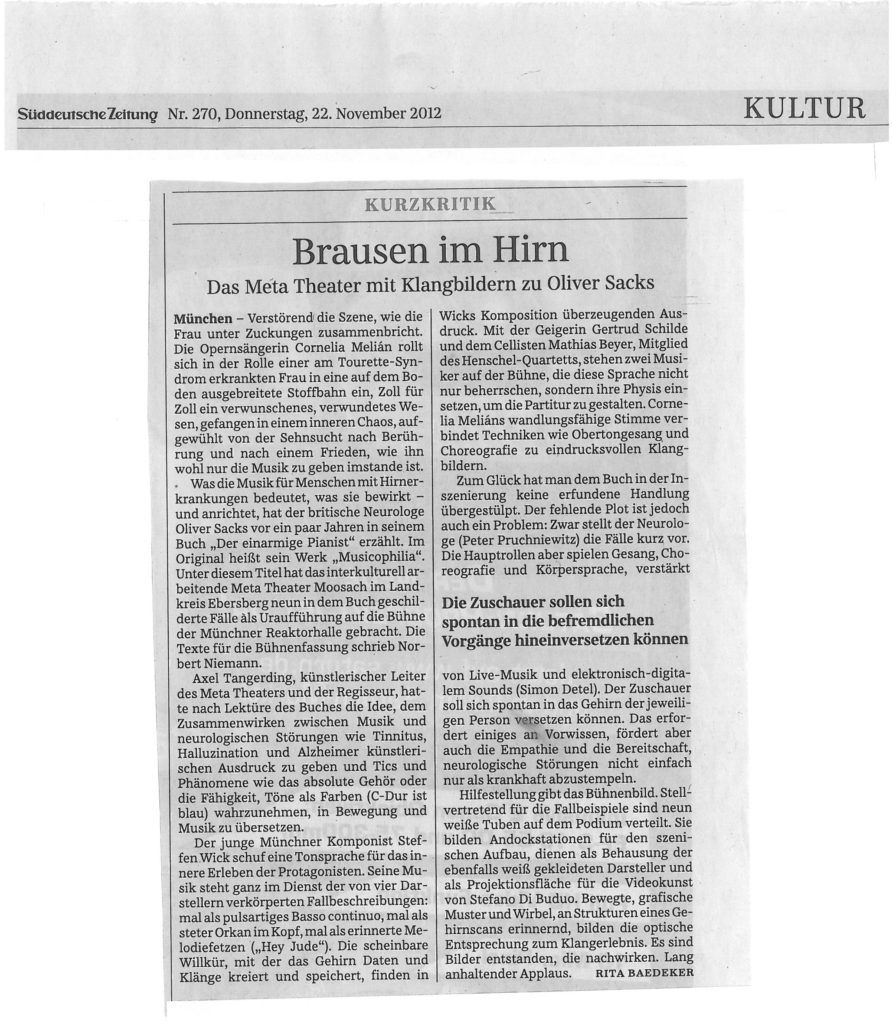Freitag 18. April 2014
20 Uhr
Samstag 19. April 2014
20 Uhr
Radialsystem V
Holzmarktstraße 33, 10243 Berlin
Musiktheater nach Oliver Sacks Bestseller „Der einarmige Pianist“ über Gehirn und Musik
An interdisciplinary music theatre project after Oliver Sacks‘ bestseller „Musicophilia“
Music meets neurology. Science meets colour. Listening for a way into our brains.
Die experimentelle Musiktheaterproduktion MUSICOPHILIA mit Figuren aus Oliver Sacks‘ Bestseller „Der einarmige Pianist“ fu¨hrt das Publikum auf eine dramatisch-poetische Reise durch das menschliche Gehirn. Erkenntnisse aus der Neurologie werden durch unerwartete Perspektiven, Farben, Choreographien und Kla¨nge ku¨nstlerisch erfahrbar: Die Grenzen zwischen a¨ußerem und innerem Erleben von „Musik“ verschwimmen in einem Kaleidoskop aus Licht, Bewegung und Klang. Ausgangspunkt der Inszenierung von Axel Tangerding ist der Bestseller des amerikanischen Neurologen Oliver Sacks, der episodenhaft von Menschen, die nach einer Hirnerkrankung ihre Musikalita¨t verlieren oder gewinnen, erza¨hlt. Autor und Bachmann-Preistra¨ger Norbert Niemann spannt in seiner Bu¨hnenfassung von „Musicophilia“ (dt. „Der einarmige Pianist“) aus unterschiedlichen Pha¨nomenen wie Tinnitus, Amusie, Demenz, Amnesie, absolutem Geho¨r oder Syna¨sthesie einen narrativen Bogen, den vier Performer zu den Kompositionen und Soundscapes von Steffen Wick und Simon Detel mit Leben erfu¨llen. Die Darsteller und Musiker werden im wo¨rtlichen Sinne zu singenden Klangko¨rpern.
Begleitet werden die Auffu¨hrungen von einem wissenschaftlichen Rahmenprogramm in Zusammenarbeit mit dem Max-Plack-Institut für Kognitions- und Neurowissenschaften, Leipzig, der Humboldt-Universität zu Berlin, der Charité-Universitätsmedizin Berlin und der Berlin School of Mind and Brain. An beiden Vorstellungsabenden erga¨nzen Vortra¨ge aus dem klinischen Alltag zum Thema Musik und Neurologie die Veranstaltungen. Die Vortra¨ge werden von Prof. Arno Villringer, Leiter des bundesweiten Kompetenznetz Schlaganfall und Gru¨nder der Exzellenzinitiative Berlin School of Mind and Brain, eingefu¨hrt und moderiert.
„Brausen im Hirn“ – SZ: „Verstörend die Szene, wie die Frau unter Zuckungen zusammenbricht. Die Opernsängerin Cornelia Melián rollt sich in der Rolle einer am Tourette-Syndrom erkrankten Frau in eine Stoffbahn ein, … aufgewühlt von der Sehnsucht nach Berührung und nach einem Frieden, wie ihn nur die Musik zu geben imstande ist. . . . Es sind Bilder entstanden, die nachwirken. Lang anhaltender Applaus.“ – Rita Baedeker
„A Boom inside the Brain“ – SZ: „In a disturbing scene, a woman convulses and collapses. A woman suffering from Tourette’s syndrome, opera singer Cornelia Melián wraps herself up in a length of material spread out on the floor, inch for inch a spellbound and wounded being, trapped in an inner chaos, troubled by the desire for stimulation and inner peace like that which only music can give. . . . The images created are long-lasting. So was the applause. – Rita Baedeker
„Hirn und Ton“ – Münchner Feuilleton: „Der Theatermacher Axel Tangerding hat den Bestseller Musicophilia adaptiert … gemeinsam mit dem Autor Norbert Niemann . . . Steffen Wick hat in seinen Kompositionen mit klassischen Strukturen gearbeitet, die sich langsam zersetzen, die Modifikationen und Zerfallsprozessen ausgesetzt sind, wie sie auch in den Gehirnen der Patienten stattfinden . . .“ – Eva Mackensen
„Brain and Sound“- Münchner Feuilleton: “Theatreman Axel Tangerding has adapted the bestseller Musicophilia – together with author Norbert Niemann . . . Steffen Wick has used classic structures which fall apart slowly and are exposed to modifications and decompositions similar to the ones of patients‘ brains. . .” Eva Mackensen
„Salzige Terz“ – SZ: „Es hört sich an wie Magie. Eine Studentin kann die Vorlesung Wort für Wort nachsingen… Ein Patient erlebt jeden Ton als Geschmack – die kleine Terz schmeckt salzig, die Quart duftet wie gemähtes Gras . . . Oliver Sacks hat Passagen für das Stück beigesteuert.“ – rb
„Salty third“ – SZ: „It sounds like magic. A student can sing word for word what she had just heard in the lecture… Another patient perceives each sound he hears as a taste – the minor third tastes salty, the fourth smells of cut grass. . . . Oliver Sacks himself has also contributed some passages to the play“ – rb
On stage: Cornelia Melián (voice/performance), Peter Pruchniewitz (actor/performance), Gertrud Schilde (violin/performance), Mathias Beyer-Karlshoj (cello/performance); Team: Axel Tangerding (artistic director), Steffen Wick (composition), Norbert Niemann (stage version), Simon Detel (sounddesign), Stefano Di Buduo (video), Stefan Staub, Axel Tangerding (light), Marc Thurow (stage/costumes); Gabi Sabo (dramaturgy); Regine Heiland (photo);
Meta Theater Production, with the kind support of the Cultural Department, City of Munich, the Funds for the Performing Arts, Berlin, the Bavarian Music Funds, Munich, and in collaboration with the University of Music and Performing Arts, Munich; 
Presse:
Zur PresseseiteHirn und Ton _ Münchner Feuilleton 10_2012

„Brain and Sound“ – Münchner Feuilleton:
Theatreman Axel Tangerding has adapted the bestseller Musicophilia – a scenic journey towards the secrets of music . . . Together with author Norbert Niemann, Tangerding has created a piece of music theatre . . . its result, a four hander for two musicians, a singer and an actor, can at best be judged an approach, an attempt to bring to life the inner world of Sacks‘ characters, to give an insight into their way of perceiving music … In his compositions, Steffen Wick has used classic structures which fall apart slowly and are exposed to modifications and decompositions similar to the ones of patients‘ brains… „When the self dissolves through illness or old age, we are left with the access to music “ – Eva Mackensen
SZ, 15.11.2012 – Salzige Terz

So harmonieren Gehirn und Musik, tz, 15.11.2012

„Salty third“ – SZ:
„Musicophilia“ lends artistic expression to the experiences of neurologically ill people„ It sounds like magic. A student can sing word for word what she had just heard in the lecture. A woman suffering from Alzheimer’s disease only repeats „Oh weh“, but interrupts her intonation when the nurse starts singing. Another patient perceives each sound he hears as a taste – the minor third tastes salty, the fourth smells of cut grass. In another case blowing the nose sounds like D major, the clock chimes in B minor and the tinnitus is heard as the high C. . . . The four performers, two musicians, a singer and an actor translate the described phenomena into snapshots, into poetic scans. . . . . . The actors enter the case studies like a vehicle with an unknown destination. They create sounds and images which let you feel what it means when the senses seem to get out of control, when you perceive C major as blue. . . . Oliver Sacks himself has also contributed some passages to the play“ – rb
Brausen im Hirn, SZ, 22.11.2012

„A Boom inside the Brain“ – SZ:
„In a disturbing scene, a woman convulses and collapses. A woman suffering from Tourette’s syndrome, opera singer Cornelia Melián wraps herself up in a length of material spread out on the floor, inch for inch a spellbound and wounded being, trapped in an inner chaos, troubled by the desire for stimulation and inner peace like that which only music can give. . . . The young composer Steffen Wick has created a musical idiom for the inner experience: … in a pulsating Basso continuo, in a continuous hurricane inside the head, in fragments of musical memories (“Hey Jude“). Wicks compositions express convincingly the purported arbitrariness with which the brain creates and stores data and sounds. With violinist Gertrud Schilde and the cellist Mathias Beyer, both members of the Henschel-Quartet, two musicians take the stage who not only master this language but who also use their physicality to give shape to the musical score. Cornelia Meliàn‘s versatile voice links techniques … into impressive sounds. . . . The nine tubes of the set … form docking stations for the scenography, serve as homes for the actors, dressed in white, and as projection screens for the video art of Stefano Di Buduo. Moving graphic pattern and swirls reminiscent of brain scans are the optical equivalent to the soundscape. The images created are long-lasting. So was the applause. – Rita Baedeker